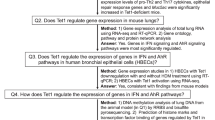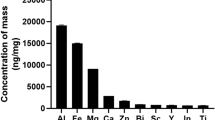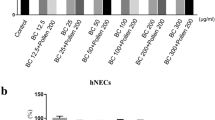Abstract
Allergic inflammatory diseases, such as asthma and allergic rhinitis, are caused by a complex interaction between genetic and environmental factors. Although several relevant candidate genes that are associated with environmental pollutants and allergic diseases have been identified in previous studies, the mechanisms underlying the induction of cytokines and chemokines by environmental pollutants and their role in human diseases are still unclear. This study examines the correlation between exposure to toluene, which is a common environmental pollutant, and the expression of immune-related genes, using reverse transcription-polymerase chain reaction (RT-PCR) with pathway-targeted arrays (RT2 Profiler™ PCR Arrays). Our PCR array analyses suggested the p38 MAPK and JNK pathways are activated upon toluene treatment in BEAS-2B cells, based on the expression profiles of MAPK8 (JNK1), MAPK9 (JNK2), MAPK10 (JNK3), MAPK11 (P38BETA2), CCL5 (RAN TES), CCL11 (eotaxin), and genes encoding proinflammatory cytokines, including tumor necrosis factor (TNF), TOLLIP, IL1A, and IL1B. This study aims to show that toluene exposure induces the expression of RANTES and eotaxin in cultured human bronchial epithelial cell lines through two distinct MAPKs, p38 and JNK.
Similar content being viewed by others
References
Herbarth, O. et al. Effect of indoor chemical exposure on the development of allergies in newborns-LARS study. Proc. Healthy Build. 1, 281–286 (2000).
Becher, R. et al. Environmental chemicals relevant from respiratory hypersensitivity: the indoor environment. Toxicol. Lett. 86, 155–162 (1996).
Brugge, D. et al. Comparison of multiple environmental factors for asthmatic children in public housing. Indoor Air. 13, 18–27 (2003).
Fiedler, N. et al. Health effects of a mixture of indoor air volatile organics, their ozone oxidation products, and stress. Environ. Health Perspect. 113, 1542–1548 (2005).
Samet, J. M. et al. Respiratory effects of indoor air pollution. J. Allergy Clin. Immunol. 79, 685–700 (1987).
Koren, H. S. & Devlin, R. B. Human upper respiratory tract responses to inhaled pollutants with emphasis on nasal lavage. Ann. NY Acad. Sci. 641, 215–224 (1992).
Bono, R. et al. Ambient air levels and occupational exposure to benzene, toluene, and xylenes in northwestern Italy. J. Toxicol. Environ. Health A. 66, 519–531 (2003).
Wieslander, G. et al. Airway symptoms among house painters in relation to exposure to volatile organic compounds (VOCS)-a longitudinal study. Ann. Occup. Hyg. 41, 155–166 (1997a).
Wieslander, G. et al. Asthma and the indoor environment: the significance of emission of formaldehyde and volatile organic compounds from newly painted indoor surfaces. Int. Arch. Occup. Environ. Health. 69, 115–124 (1997b).
Richter, M. et al. Redecoration of apartments promotes obstructive bronchitis in atopy risk infants-results of the LARS-study. Int. J. Hyg. Environ. Health. 206, 173–179 (2003).
Herbarth, O. et al. Effect of indoor chemical exposure on the development of allergies in newborns-LARS study. Proc. Healthy Build. 1, 281–286 (2000a).
Devalia, J. L. et al. Effect of nitrogen dioxide on synthesis of inflammatory cytokines expressed by human bronchial epithelial cells in vitro. Am. J. Respir. Cel. Mol. Biol. 9, 271–279 (1993).
Noah, T. L. et al. The response of a human bronchial epithelial cell line to histamine: intracellular calcium changes and extracellular release of inflammatory mediators. Am. J. Respir. Cell. Mol. Biol. 5, 484–492 (1991).
Alam, R. Updates on cells and cytokines: chemokines in allergic inflammation. J. Allergy Clin. Immunol. 99, 273–277 (1997).
Marini, M. et al. Interleukin-1 binds to specific receptors on human bronchial epithelial cells and upregulates granulocyte/macrophage colony-stimulating factor synthesis and release. Am. J. Respir. Cell. Mol. Biol. 4, 519–524 (1991).
Mattoli, S. et al. Bronchial epithelial cells exposed to isocyanates potentiate activation and proliferation of T-cells. Am. J. Physiol. 259, L320–327 (1990).
Braunstahl, G. J. et al. Segmental bronchial provocation induces nasal infl ammation in allergic rhinitis patients. Am. J. Respir. Crit. Care Med. 161, 2051–2057 (2000).
Schall, T. J. et al. Selective attraction of monocytes and T lymphocytes of the memory phenotype by cytokine RANTES. Nature 347, 669–671 (1990).
Stellato, C. et al. Expression of the C-C Chemokine receptor CCR3 in human airway epithelial cells. J. Immunol. 166, 1457–1461 (2001).
Aaron, S. D. et al. Granulocyte inflammatory markers and airway infection during acute exacerbation of chronic obstructive pulmonary disease. Am. J. Respir. Crit. Care Med. 163, 349–355 (2001).
Soler, N. et al. Airway inflammation and bronchial microbial patterns in patients with stable chronic obstructive pulmonary disease. Eur. Respir. J. 14, 1015–1022 (1999).
Shruti, J. et al. A computational model for cell survival/death using VHDL and MATLAB simulator. Dig. J. Nanomater. Bios. 4, 863–879 (2009).
Teran, L. M. et al. Leukocyte recruitment after local endobronchial allergen challenge in asthma. Relationship to procedure and to airway interleukin-8 release. Am. J. Respir. Crit. Care Med. 154, 469–476 (1996).
Montefort, S. Bronchial biopsy evidence for leukocyte infiltration and upregulation of leukocyte-endothelial cell adhesion molecules 6 hours after local allergen challenge of sensitized asthmatic airways. J. Clin. Invest. 93, 1411–1421 (1994).
Frew, A. J. et al. Cellular and mediator responses twenty-four hours after local endobronchial allergen challenge of asthmatic airways. J. Allergy Clin. Immunol. 98, 133–143 (1996).
Han, J. et al. A MAP kinase targeted by endotoxin and hyperosmolarity in mammalian cells. Science 265, 808–811 (1994).
Waskiewicz, A. J. & Cooper, J. A. Mitogen and stress response pathways: MAP kinase cascades and phosphatase regulation in mammals and yeast. Curr. Opin. Cel. Biol. 7, 798–805 (1995).
Raingeaud, J. et al. Pro-inflammatory cytokines and environmental stress cause p38 mitogen-activated protein kinase activation by dual phosphorylation on tyrosine and threonine. J. Biol. Chem. 270, 7420–7426 (1995).
Hashimoto, S. et al. Hyperosmolarity-induced IL-8 expression in human bronchial epithelial cells through p38 MAP kinase. Am. J. Respir. Crit. Care Med. 159, 634–640 (1999).
Kyriakis, J. M. & Avruch, J. Protein kinase cascades activated by stress and inflammatory cytokines. Bioessays 18, 567–577 (1996).
Xia, Z. et al. Opposing effects of ERK and JNK-p38 MAP kinases on apoptosis. Science 270, 1326–1331 (1995).
Marais, R. & Marshall, C. J. Control of the ERK MAP kinase cascade by Ras and Raf. Cancer Surv. 27, 101–125 (1996).
Keren, A., Tamir, Y. & Bengal, E. The p38 MAPK signaling pathway: A major regulator of skeletal muscle development. Mol. Cell Endocrinol. 27, 224–230 (2006).
Schiller, M. et al. Mitogen- and stress-activated protein kinase 1 is critical for interleukin-1-induced, CREB-mediated, c-fos gene expression in keratinocytes. Oncogene 27, 4449–4457 (2006).
Bahia, M. S. & Silakari, O. Tumor necrosis factor alpha converting enzyme: an encouraging target for various inflammatory disorders. Chem. Biol. Drug. Des. 75, 415–443 (2010).
Wajant, H., Pfizenmaier, K. & Scheurich, P. Tumor necrosis factor signaling. Cell Death Differ. 10, 45–65 (2003).
Concetta, C., Maria, G. & Salvatore, C. Effects of genetic and pharmacological inhibition of TNF-α in the regulation of inflammation in macrophages. Pharmacological Research 60, 332–340 (2009).
Eyers, P. A. et al. Conversion of SB 203580-insensitive MAP kinase family members to drug-sensitive forms by a single amino-acid substitution. Chem. Biol. 5, 321–328 (1998).
Dudley, D. T. et al. A synthetic inhibitor of the mitogen-activated protein kinase cascade. Proc. Natl. Acad. Sci. 92, 7686–7689 (1995).
Himes, S. R. et al. The JNK are important for development and survival of macrophages. J. Immunol. 176, 2219–2228 (2006).
Yang, Q. et al. Tumour necrosis factor receptor 1 mediates endoplasmic reticulum stress-induced activation of the MAP kinase JNK. EMBO Rep. 7, 622–627 (2006).
Hashimoto, S. et al. p38 MAP kinase regulates TNF-α, IL-1- and PAF-induced RANTES and GM-CSF production by human bronchial epithelial cells. Clin. Exp. Allergy 30, 48–55 (2000).
Rahman, M. S. et al. IL-17A induces eotaxin-1/CC chemokine ligand 11 expression in human airway smooth muscle cells: role of MAPK (Erk1/2, JNK, and p38) pathways. J. Immunol. 177, 4064–4071 (2006).
Author information
Authors and Affiliations
Corresponding author
Additional information
These authors contributed equally to this work.
Rights and permissions
About this article
Cite this article
Kim, YR., Kim, IK., Lee, S.H. et al. Gene expression profiles of human lung epithelial cells exposed to toluene. Toxicol. Environ. Health Sci. 4, 269–276 (2012). https://doi.org/10.1007/s13530-012-0146-1
Received:
Revised:
Accepted:
Published:
Issue Date:
DOI: https://doi.org/10.1007/s13530-012-0146-1




